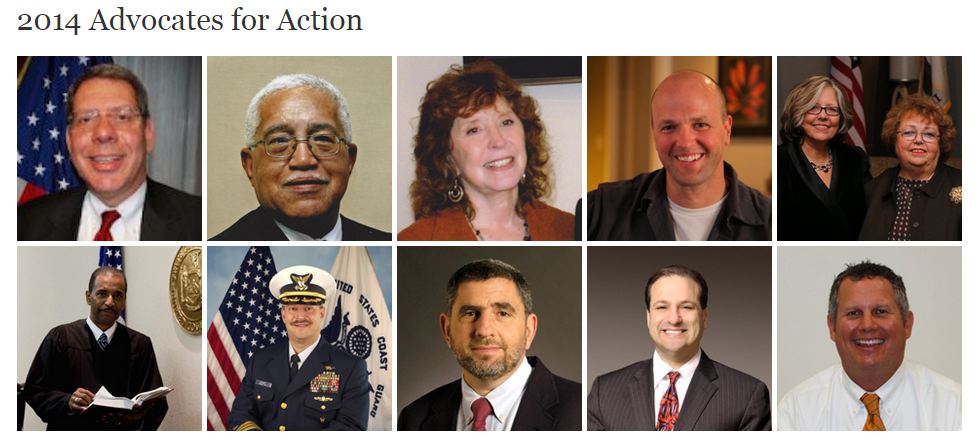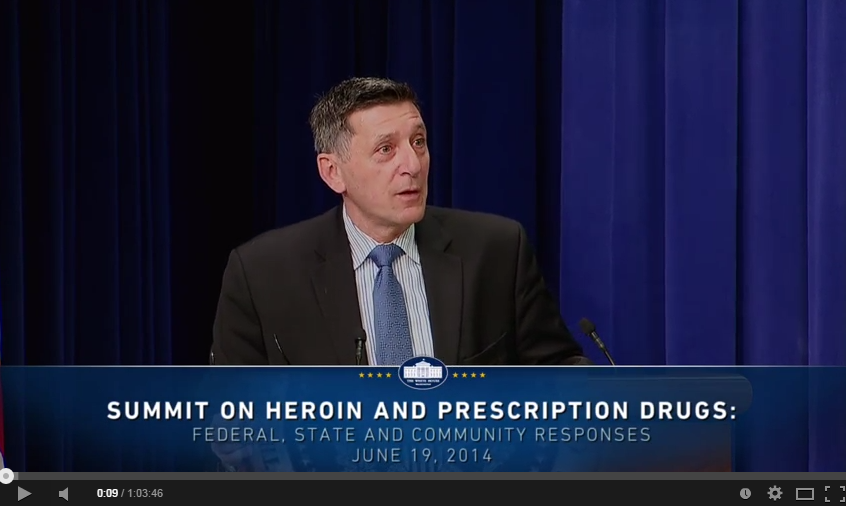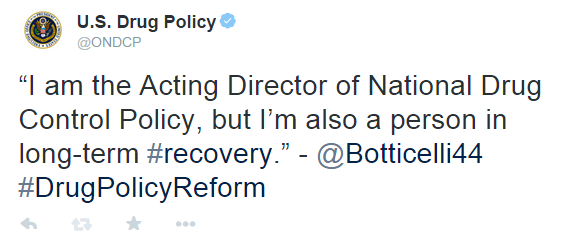ONDCP Blog
Recovery Story: Patrick Kelley, Photographer to the Commandant of the Coast Guard
Posted by on April 3, 2015 at 4:31 PM EDTWhen Coast Guard Petty Officer Patrick Kelley met Director Michael Botticelli last November on a flight to Panama for an Interdiction Committee meeting, they instantly bonded over their similar past: Both men are in long-term recovery from alcohol use disorders. For Kelley, Botticelli’s journey from alcoholic to 26-years-sober Director of National Drug Control Policy was inspiring – so much so that he decided to share his own recovery story with the Office of National Drug Policy.
Two years ago, Kelley was in a dark place. His marriage was failing, and he found himself routinely drinking to excess, alone. He was hesitant to admit his alcohol problem to his Coast Guard colleagues because he worried that admitting he had an alcohol use disorder would damage his reputation or force him out of his job.
After his decade-long struggle with alcohol culminated in one awful night, Kelley finally opened up about his substance use disorder and sought help within the Coast Guard community. He was amazed by the response: His friends and peers rallied around him and helped him into treatment. His biggest fear had been getting kicked out of the Coast Guard, but the opposite happened. He found that the Coast Guard has a compassionate, evidence-based response to service members in need of treatment for substance use disorders.
In November 2014, the U.S. Coast Guard Headquarters established a 12-step support group that helps ensure that service men and women struggling with substance use disorders don’t have to feel isolated when seeking treatment.
Director Botticelli sat down in March with Rear Admiral Maura Dollymore, the Coast Guard’s Director of Health, Safety and Work-Life, and other senior staff for a Coast Guard Prevention and Treatment roundtable discussion. At the meeting, Coast Guard leadership talked about the newly formed support group that helps service members like Kelley through treatment, and Director Botticelli offered his support for the Coast Guard’s prevention and treatment initiatives.
Watch Patrick Kelley’s story, and share it with someone you know:
Learn more about‘Reality TV’: House of Cards Highlights the Importance of Prescriber Education
Posted by on March 27, 2015 at 7:00 AM EDTSpoiler alert: This post discusses House of Cards Season 3.
Although House of Cards is known mostly for its political drama and manipulative characters, season three’s story line about character Doug Stamper has highlighted the importance of prescriber education and the realities of relapse during recovery.
After Doug’s six-month hospitalization to rehabilitate his leg, his doctor prescribes medication to address his anxiety and depression. She tells Doug she cannot prescribe him painkillers because of his history with alcohol use disorder. Yet after he falls and breaks his arm in the shower, an emergency room doctor prescribes Percocet, a mix of oxycodone and acetaminophen. Although Doug had been in recovery and attending Alcoholics Anonymous meetings for 14 years, the prescription triggers a relapse. Initially regulating the amount of alcohol he drinks with a syringe, Doug eventually begins drinking uncontrollably until he meets with President Frank Underwood while intoxicated and asks for help. With the help of his brother, Doug is able to get sober again and become the President’s Chief of Staff.
In recent years, the number of filled opioid prescriptions has increased dramatically. Although opioid pain relievers are among the most powerful medications available and can effectively relieve suffering for many patients, they also present grave potential for misuse.
The first and most crucial step for the prevention of opioid misuse is to educate drug prescribers and dispensers. Practitioners, nurses, and pharmacists have a role to play in reducing prescription drug misuse. Unfortunately, prescribers receive little training in the risks associated with dispensing opioid pain relievers, especially for persons in recovery.
The physician who treated Doug’s leg was familiar with her patient’s medical history. She knew an opioid prescription would be detrimental to his journey in long-term recovery. Meanwhile, the emergency-room doctor, who met with Doug only briefly, prescribed a highly addictive painkiller without first asking if Doug had any history of substance use or disorder. As we learn from House of Cards, it is essential that prescribers receive training regarding the substance use history of patients to prevent triggering a relapse for those in recovery.
It is important to note, however, that Doug’s relapse was not out of the ordinary. A substance use disorder is a chronic disease, which means that for many in recovery, relapse is not only possible, but likely. Relapse rates for substance use disorders are between 40 and 60 percent—similar to those for other chronic medical conditions, such as diabetes, hypertension, and asthma. Just like these other conditions, substance use disorders do not discriminate: Anyone can possess the risk factors or fall into the cycle of misuse. Relapse is never a sign of failure for any patient; rather, it is a speed bump on the road to recovery. It is essential that prescribers receive training to aid in the recovery process and make this journey as smooth as possible.
Doug Stamper is a fictional character in a dramatized television show, but his story of recovery and relapse is far from fictional. House of Cards illustrates how imperative it is for prescribers to know their patients’ histories before prescribing opioids. Doug’s story serves as a reminder to the friends and families of persons in long-term recovery that relapse of a substance-use disorder is as much a reality as it would be for any chronic medical condition, but that with their love and support, recovery is completely attainable.
Learn more aboutCommission on Narcotic Drugs Endorses Alternatives to Incarceration for Substance Use Disorders
Posted by on March 26, 2015 at 10:23 AM EDTEarlier this month, the United Nations Commission on Narcotics Drugs (CND) approved a resolution that called for justice and health agencies to work together to provide a range of alternatives to incarceration for those affected by a substance use disorder. The CND, held in Vienna, Austria, is the largest annual governmental meeting on drug issues with 53 member states. The White House Office of National Drug Control Policy initially proposed the resolution.
“A global consensus is emerging that no nation can solve its drug problem by simply arresting and incarcerating those affected by a substance use disorder,” said Director of National Drug Control Policy Michael Botticelli, who represented the United States at the CND. “The United States is strongly committed to advancing strategies that bring justice and health agencies together on innovative solutions for drug-involved individuals wherever they are in the world.”
The United States introduced the resolution, which emphasizes that too many individuals with substance use disorders around the world are serving extended prison sentences, but not receiving evidence-based treatment or other needed health services. Increasing the use of alternatives to incarceration and the provision of treatment for these individuals, whether in the community or in prison, supports sustained recovery from substance use disorders, promotes fairness, and reduces prison overcrowding.
The resolution encourages all countries to utilize a range of alternatives to incarceration and other criminal justice reforms that also promote treatment for substance use disorders. The health-related interventions referenced in the resolution include screening for substance use disorders, access to treatment, including medication-assisted treatment, counselling services and other behavioral health services, overdose prevention and treatment, recovery support services, treatment for HIV, hepatitis, and other infectious diseases and mental health disorders. The alternatives to incarceration and other reforms listed include reduced or suspended sentences, diversion programs before or during trial, home detention, community service, fines, victim restitution, random drug testing, and GPS tracking.
Effective combinations of supervision and drug treatment, which are a subject of ongoing research in the United States, can result in more effective crime reduction, better health outcomes and lower prison costs. These alternatives can also allow incarcerated individuals with substance use disorders to return to their families and communities, while concurrently receiving treatment and helping to break the cycle of drug use, arrest, incarceration, relapse and re-arrest.
The resolution, specifically called for the following:
- Greater collaboration between health and justice agencies on alternatives to incarceration;
- Establishment of mechanisms to “break down the silos” between health and justice agencies so they can work together better to provide health services for those under criminal justice supervision;
- Training for justice officials on the effectiveness and importance of evidence-based treatment for substance use disorders;
- Recommendation that governments review their drug sentencing practices to ensure that they allow for alternatives to incarceration for those affected by a substance use disorder;
- Collection and sharing of best practices and research on collaborations between justice and health agencies on alternatives to incarceration for those with a substance use disorder;
The full title of the resolution is: Supporting the Collaboration of Public Health and Justice Authorities in Providing Alternatives to Conviction or Punishment for Drug-Related Offenses of a Minor Nature. The following countries co-sponsored the resolution: Australia, Ecuador, El Salvador, European Union, Germany, Greece, Guatemala, Israel, Lithuania, Mexico, Namibia, and Uruguay.
Learn more aboutCelebrating Five Years of the Affordable Care Act
Posted by on March 23, 2015 at 1:56 PM EDTNora Zarabia faced a difficult – and all too common -- question when her 20-year-old son, Alex, was diagnosed with a substance use disorder. How was she going to pay for the help he needed?

Fortunately for Alex, Nora’s health insurance – thanks to the Affordable Care Act (ACA) – allowed him the opportunity to receive addiction treatment and care under her policy until age 26. After that, he can obtain insurance on his own that will cover his treatment needs. The ACA requires insurers to cover mental health and substance use disorder treatment at the same level they’d cover any other medical treatment. Without the care he received, Alex may not have entered recovery and gotten back on track at school, building the life he and his mom had hoped for.

As we celebrate the fifth anniversary of the Affordable Care Act becoming law, we celebrate that millions more people have health insurance than before. And that’s not all there is to celebrate. The ACA establishes the biggest expansion of mental health and substance use disorder coverage in a generation. It requires insurers to provide mental health and substance use disorder benefits at parity with coverage for any other medical condition, like diabetes or heart diseases. In total, this expansion creates new opportunities for substance use disorder and mental health care for more than 60 million Americans.[i]

Research highlights an increase in utilization of inpatient care for mental health and substance use disorder services among young adults between 2010 and 2012, according to the Health Care Cost Institute.[i]
The Affordable Care Act offers a profound change for those who suffer from substance use disorders – one that has proven time and time again to save lives. Millions of Americans, like Nora and Alex, have had a burden lifted by having options and access to quality care.
The Obama Administration is committed to restoring a balance to U.S. drug-control efforts by focusing on public health to reduce drug use and its consequences. By decreasing the number of uninsured Americans and cutting costs, the Affordable Care Act plays a crucial role in connecting Americans to the resources they need.
We’ve made great progress: after five years of the Affordable Care Act, 16 million people have gained health coverage.
That’s something to cheer about. So on this anniversary, let’s celebrate opportunity and progress – for our loved ones, for our communities, and for our nation.
[i] Health Care Cost Institute, Issue Brief No. 8: Selected Health Care Trends for Young Adults (ages 19-25): 2007-2012. September 2014. Available online at http://www.healthcostinstitute.org/files/IB8_YA_09242014.pdf.
[i] U.S. Department of Health & Human Services, ASPE Issue Brief: Affordable Care Act Expands Mental Health and Substance Use Disorder Benefits and Federal Parity Protections for 62 Million Americans. February 2013. Available online at http://aspe.hhs.gov/health/reports/2013/mental/rb_mental.cfm
Learn more aboutThe Work Before Us: A Message from Michael Botticelli
Posted by on February 9, 2015 at 6:46 PM EDTMany great movements to change public perception and policy around a public health issue have been fueled by people with a disease speaking out publicly. What is seen as someone else's problem—someone else’s disease – takes on a new dimension when people speak up about it.
Such was the case when Betty Ford revealed her breast cancer diagnosis and her substance use disorder. Such was the case when Magic Johnson revealed that he was HIV positive, spurring action to stem the AIDS epidemic.
Yet, despite the fact that nearly every family and community in America is affected by a substance use disorder, those fighting to overcome this disease are too often hidden in the shadows of shame and denial. It is whispered about. It is met with derision and scorn.
According to the National Survey on Drug Use and Health, only 1 in 9 people with a diagnosable substance use disorder gets treatment. Compare this to the treatment rate for diabetes, for which 72% of people with the disease receive care.
When treatment is provided for substance use disorders, it too often comes at the most acute stages of the disease when effective treatment is far more challenging and costly than in the early stages. Because substance use disorders have historically gone unidentified for far too long, and timely access to treatment has been far too difficult to come by, a person is expected to hit “rock bottom” before seeking help for a substance use disorder.
Standard medical care does not allow a diabetic to enter kidney failure before offering insulin. Yet untreated substance use disorders routinely proceed unchecked until they have reached such levels of emergency. In addition to the unnecessary suffering for patients and their families, our current approach costs the United States hundreds of billions a year in increased health care costs, crime and lost productivity-- over $223 billion related to alcohol and $193 billion related to illicit drugs.
Decades of scientific research have proven that substance use disorders are a health issue: chronic medical conditions with genetic, biological and environmental risk factors. Effective substance use disorders requires a comprehensive, public health approach involving evidence-based prevention, early intervention, treatment and recovery support services. The National Drug Control Strategy, the Obama Administration’s template for drug policy, outlines more than 100 action items across federal government to prevent drug use and its consequences.
Earlier this month, President Obama in his 2016 Budget requested historic levels of funding --including $133 million in new funds-- to address the opioid misuse epidemic in the U.S. Using a public health framework as its foundation, our strategy also acknowledges the vital role that federal state and local law enforcement play in reducing the availability of drugs—another risk factor for drug use. It underscores the vital importance of primary prevention in stopping drug use before it ever begins by funding prevention efforts across the country. It sets forth an agenda aimed at stripping away the systemic challenges that have accumulated like plaque over the decades: over-criminalization, lack of integration with mainstream medical care, insurance coverage and the legal barriers that make it difficult for people once involved with the criminal justice system to rebuild their lives.
The implementation of the Affordable Care Act will dramatically increase coverage for treatment and ensures that services are comparable to other chronic conditions for more than 60 million Americans. This is the biggest expansion of substance use disorder treatment in a generation, and it will transform millions of lives.
All of these advancements, however, are not enough unless we fundamentally change the way we think about people with addiction. There are millions of people in recovery in the United States leading meaningful, productive lives full of joy and love and laughter – and I am one of them.
Tonight, the United States Senate voted to confirm my nomination as Director of National Drug Control Policy. This is an honor I never dreamed of 26 years ago, when my substance use disorder had become so acute that I was handcuffed to a hospital bed. I accept this challenge with the humility and tenacity of someone in long term recovery.
I am open about my recovery not to be self-congratulatory, I am open about my recovery to change public policy. I have dedicated my life to treating drug use as a public health issue, and that’s how I approach this new role, as well. I hope that many more of the millions of Americans in recovery like me will also choose to “come out” and to fight to be treated like anyone else with a chronic disease. By putting faces and voices to the disease of addiction and the promise of recovery, we can lift the curtain of conventional wisdom that continues to keep too many of us hidden and without access to lifesaving treatment.
It is time to make a simple, yet courageous decision to be counted, to be seen and to be heard.
Share your story with us today.
Michael Botticelli serves as Acting Director of National Drug Control Policy. Today, the U.S. Senate voted to confirm him as Director of National Drug Control Policy.
Learn more aboutHistoric Requests for Treatment and Prevention in President Obama’s 2016 Budget
Posted by on February 2, 2015 at 3:09 PM EDTToday, President Obama released a budget that shows what we can do if we invest in America’s future. The Budget outlines a strategy to strengthen the middle class and provide opportunity to anyone willing to work for it. Too often, however, in too many towns across America, substance use disorders dim students’ potential and diminish hard-working Americans’ opportunities.
In response to America’s drug problem, the 2016 Budget reflects the Administration’s ongoing commitment to reducing drug use and its consequences through a balanced approach rooted in science.
The President’s 2016 Budget, submitted to Congress today, contains over $12 billion in Federal funds -- an increase of more than $768 million over FY 2015 – for drug demand reduction programs essential to making our Nation a healthier and safer place. The $1.4 billion funding request for prevention activities increased nearly six percent over the 2015 funding level, and the $11 billion requested for treatment represents a nearly seven percent increase. Together, these funding requests amount to the largest commitment to treating and preventing substance use disorders to date.
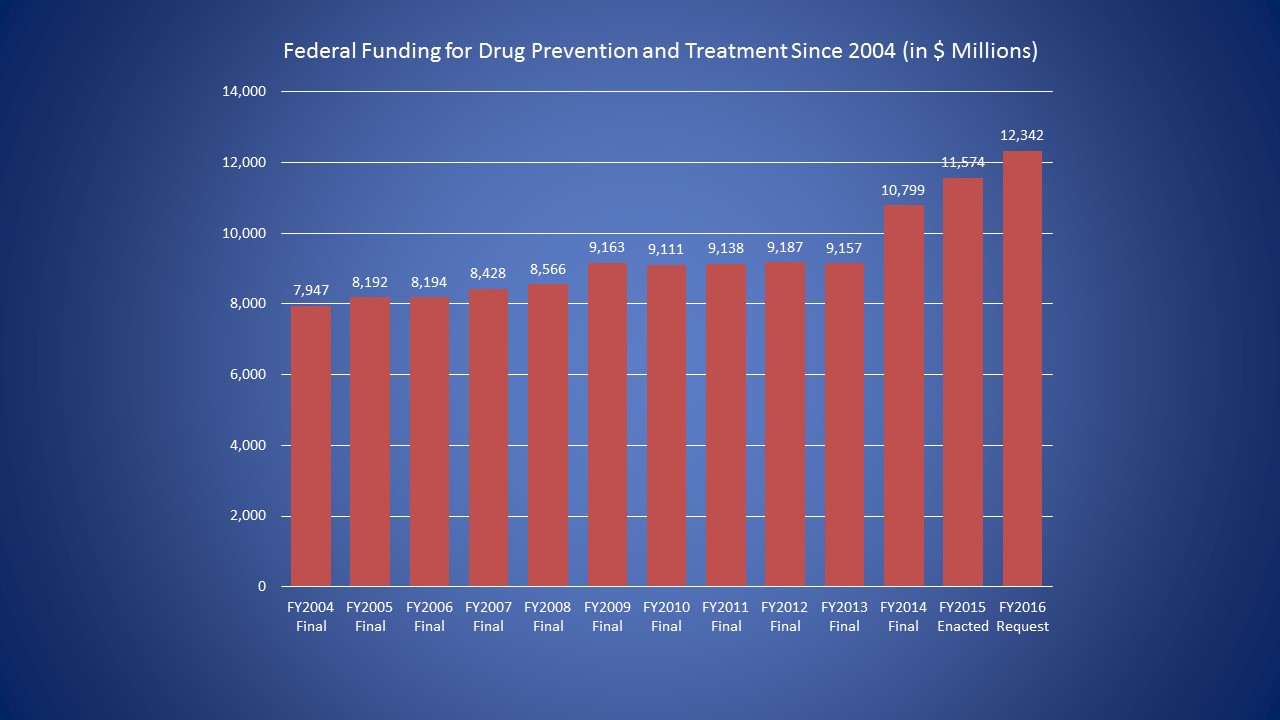
Consistent with the Administration’s balanced approach to public health and public safety, the Budget also calls for increases for supply reduction programs that disrupt the flow of illicit drugs into our country and reduce drug trafficking domestically. This includes$9.7 billion for domestic law enforcement activities, a nearly four percent increase over the FY 2015 funding level; $3.9 billion for interdiction, an increase of two percent; and $1.6 billion for international funding, an increase of more than one percent.
The Budget requests $85.7 million for the Drug Free Communities program, a local, community-based coalition program supporting nearly 700 local drug prevention groups, and $193.4 million to facilitate greater collaboration across federal, state, local and tribal law enforcement through the High Intensity Drug Trafficking Areas (HIDTAs) Program.
Reducing drug use and its harms is a complex challenge that requires coordination between a broad array of government agencies at the federal, state and local level, community advocates, non-profits and civil society organizations. The President’s 2016 Budget underscores this Administration’s commitment to a balanced approach that treats drug use as a public health issue and directs valuable law enforcement resources to combating serious public safety threats.
- Get the fact sheet
- Read the release
- See the full budget highlights
Learn more aboutLearn How to Transform Your Community and Change Lives
Posted by on January 23, 2015 at 5:35 PM EDTIn my home state of New Mexico, substance abuse and addiction present serious challenges to our families and way of life.
The destructive influence of drugs and
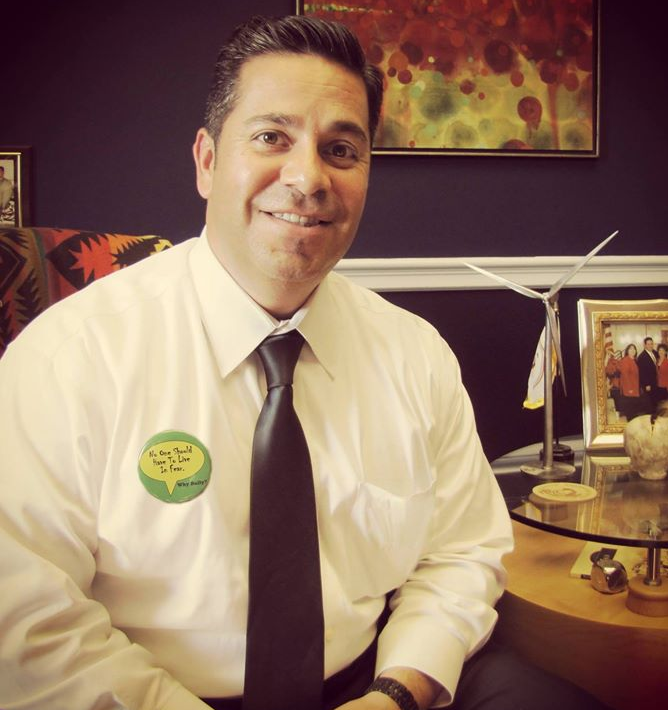 crime that threaten our communities require a holistic approach and dedication – and this means coming together to help those in need who suffer from addiction, to help prevent youth from ever using, and to stand opposed to those who traffic these dangerous substances. This is not a unique challenge to New Mexico, but one that cities and towns across America confront. In my district, one of the organizations that has been successful in getting results has been the Taos Alive Coalition, and one of the things that has aided them in their missions has been the grant they received from the Drug-Free Communities (DFC) Support Program.
crime that threaten our communities require a holistic approach and dedication – and this means coming together to help those in need who suffer from addiction, to help prevent youth from ever using, and to stand opposed to those who traffic these dangerous substances. This is not a unique challenge to New Mexico, but one that cities and towns across America confront. In my district, one of the organizations that has been successful in getting results has been the Taos Alive Coalition, and one of the things that has aided them in their missions has been the grant they received from the Drug-Free Communities (DFC) Support Program.The Taos Alive Coalition came together when a collaboration of the Taos and regional programs applied for funding through the Drug-Free Communities Support Program in 2010. In the past five years Taos Alive has worked on numerous fronts, including prescription drugs, alcohol, and synthetic drugs. Its prescription drug initiative has been one of the most successful initiatives to date – establishing the permanent drop boxes in our community and successfully assisting with bi-annual Prescription Drug Take Back events. Before the Taos Alive Coalition formed with DFC funding, Take Back Taos County collected less than 3 pounds of drugs. With the involvement of Taos Alive, they estimate that more than 65 pounds was collected. Further, Taos Alive—whose members include medical professionals from government and private practice--created opioid prescribing guidelines in the local emergency room and is working on community opioid prescribing guidelines. Youth media prescription drug training is given to all Taos High School youth & school staff in Taos County; and they have helped several schools to create prescription drug policy & procedures.
Through these community efforts, Taos Alive is improving its community and making it a safer place to live. And it is able to do this so effectively, in part, because of the Drug-Free Communities Grant from the Office of National Drug Control Policy. Since the passage of the DFC Act in 1997, the DFC Program has funded more than 2,000 coalitions and currently mobilizes nearly 9,000 community volunteers across the country. Grantees establish and strengthen collaboration among communities – public and private non-profit agencies – as well as Federal, state, local, and tribal governments to support the efforts of community coalitions working to prevent and reduce substance use among youth and, over time, reduce substance abuse among adults by addressing the factors in a community that increase the risk of substance abuse and promoting the factors that minimize the risk of substance abuse.
The FY 2015 DFC Request for Applications (RFA) has been released and is available online. In recognition of how transformative these grants are, and to assist community groups with the application process, ONDCP is hosting workshops on the technical aspects of filling out grant applications. While these workshops are not mandatory, they will offer guidance on the process that many groups that are less experienced filling out grant applications may find useful. Workshops will be held on:
Tuesday, January 27, 2015Sheraton Albuquerque Uptown2600 Louisiana Boulevard NortheastAlbuquerque, NM 87110Check-in: 8:00 a.m.Workshop: 8:30 a.m. - 3:00 p.m.Native American/American Indian Support Workshop: 3:00 - 4:00 p.m.Thursday, January 29, 2015Atlanta Airport Marriott4711 Best RoadAtlanta, GA 30337Friday, February 6, 2015 (after CADCA’s National Leadership Forum)Gaylord National Hotel & Convention Center201 Waterfront St.National Harbor, MD 20745A videotaped version of this workshop is also available on the ONDCP website. Register for the workshops and find information about the Drug Free Communities Program.
I’m proud of the work I have seen from the DFC grantees in my district, and know that they are succeeding around the country. A DFC grant is one way for communities to come together to fight back against the influence of substance abuse and addiction. Commitment and collaboration are essential tools for change, and working together we can help our family, friends, and towns heal and thrive.
Congressman Ben Ray Luján represents New Mexico's Third Congressional District.
Learn more aboutTreatment, Recovery and the ACA: Watch Live Weds., Jan 21 at 2:30 p.m.
Posted by on January 20, 2015 at 1:55 PM EDTTonight, when President Obama delivers the State of the Union, he will share how the Affordable Care Act has made quality, affordable health coverage available to millions of Americans. The Affordable Care Act also provides one of the largest expansions of mental health and substance use disorder coverage in a generation by requiring insurers to provide mental health and substance use disorder benefits at parity with coverage for any other disease.
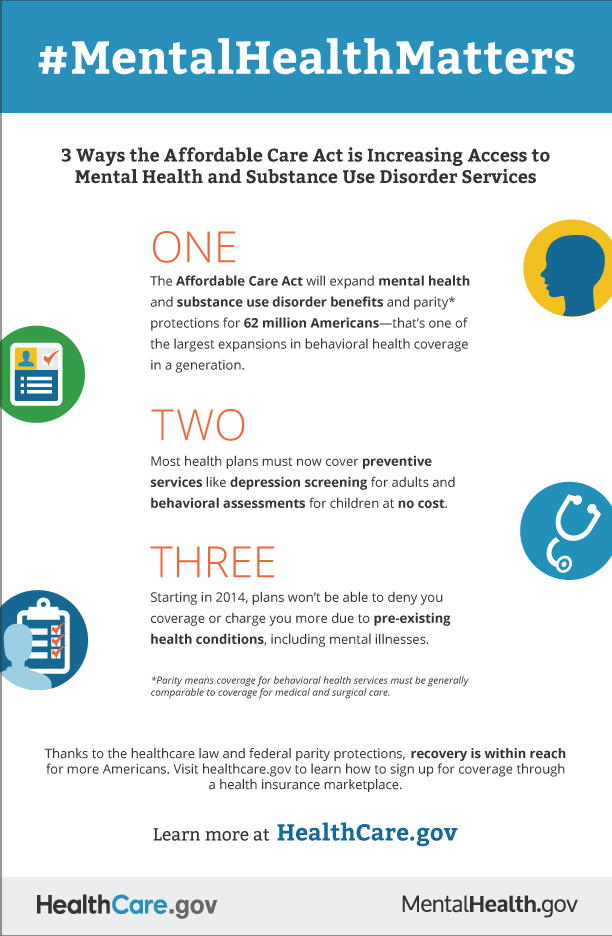
Tomorrow, we will explore how the Affordable Care Act is changing the way substance use disorders are treated in America.
On Wednesday, January 21 at 2:30 p.m. EST, we will convene experts from the substance use disorder treatment and recovery fields for a meeting titled “Treating Substance Use Disorders Today: Access, Recovery, and the Affordable Care Act”.
Watch this meeting live starting at 2:30 p.m. EST on whitehouse.gov/live.
During this meeting, which will be co-hosted by the Substance Abuse and Mental Health Services Administration (SAMHSA), we will hear from a panel of experts and from real people who are able to access treatment and recovery support services for themselves or family members.
If you can’t join us in person, we invite you to host a viewing party. You can register your viewing party here. You can also join the conversation on Twitter by including #ACA4Recovery in your tweets all day tomorrow.
Learn more about what the Affordable Care Act means for behavioral health with this infographic from our partners at SAMHSA:
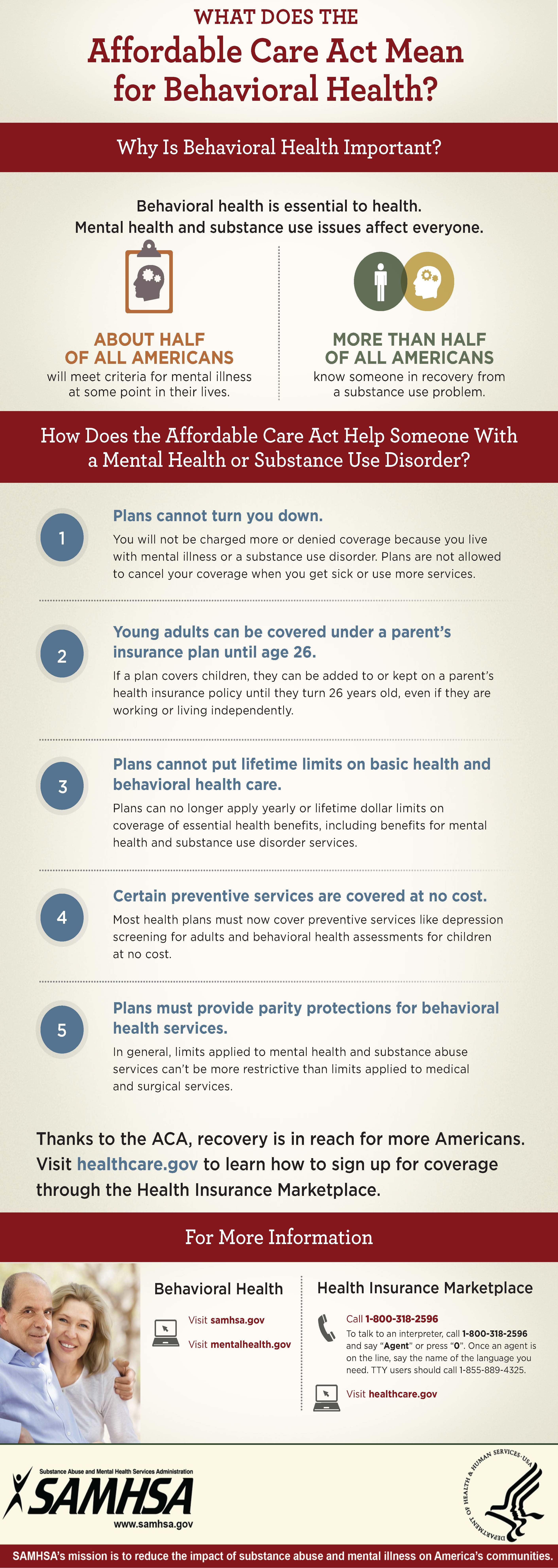
SAMHSA Enrollment and Outreach Resources
Learn more aboutSecuring our Nation’s Caribbean Border
Posted by on January 16, 2015 at 5:00 PM EDTIn 2009, President Obama signed an Executive Order that expanded the purview of the President’s Task Force on Puerto Rico to seek advice and develop recommendations on policies for the island that promote job creation, education, health care, clean energy, economic development, and public safety. Addressing these issues has been an on-going effort for the Task force and the Administration. Today, the President announced the release of the 2015 Caribbean Border Counternarcotics Strategy, a major step forward on matters of utmost importance to the people of Puerto Rico – public health and public safety.
By delivering on this important recommendation, the Obama Administration, in an effort spearheaded by the Office of National Drug Control Policy, seeks to substantially reduce the threat posed by drug trafficking, transnational organized crime, and associated violence to Puerto Rico and the U.S. Virgin Islands.
In its 2011 report to the President, the Task Force concluded that both the capacity of local law enforcement and the efforts of the Federal agencies charged with public safety in Puerto Rico require a significant amount of attention from Federal and local stakeholders.
Strengthening Public Safety
Public safety is a major challenge in Puerto Rico. During the Task Force’s public hearings, residents of Puerto Rico raised concerns about crime and the law enforcement response. The homicide rate in Puerto Rico is alarmingly high. Puerto Rico’s geographic location, with approximately 300 miles of unprotected shoreline, makes it especially vulnerable to transnational crime. Located along the Mona Passage, a heavily used shipping lane between the Dominican Republic and Puerto Rico, the region has become an increasingly important point for drug trafficking between South America and the continental United States and Europe.
Drug traffickers have long used this region as a transshipment point. Recently however, the nature of the trafficking has changed. Due to stepped-up law enforcement efforts, drug traffickers have decreased air activity and increased maritime shipping. There has also been an increase in detected maritime transport of cocaine loads to the Puerto Rico area. According to the Puerto Rico Police Department, high homicide rates can be attributed to power struggles and turf wars among violent gangs and drug trafficking organizations whose members compete to supply the demand for both illegal and diverted legal drugs. These groups frequently use intimidation, violence, and murder to gain and retain control of retail drug markets.
Cocaine is the principal drug threat and a source of associated violence throughout the Caribbean. The trafficking threat and violence is also associated with marijuana, heroin, and prescription drugs. Illicit trafficking is a highly fluid enterprise. The documented cocaine flow from the source zone to the United States via the Caribbean—including Puerto Rico, the Dominican Republic, and Eastern Caribbean countries—has more than doubled in the past three years, from 38 metric tons (MT) in 2011, to 59 MT in 2012 and 91 MT in 2013, according to the interagency Consolidated Counterdrug Database. This marks the highest documented cocaine flow since 2003.
Unlawful firearms trafficking also poses a threat to public safety and contributes to the high homicide rate and drug-related violence. The danger posed to children by the drug trade and gang violence continues to increase. Criminal incidents that frequently occur in the school system include violence, vandalism, and property theft. As drug trafficking activities increase in the region, so do related financial crimes. Trafficking organizations have displayed limited sophistication in money laundering. Rudimentary schemes to use the drug proceeds, either laundered through the financial system or transported to foreign locations, have been used in bulk-cash smuggling operations. These conditions create an environment conducive to a broad range of corruption activities.
In light of these challenges, the Task Force recommended that the various Federal agencies with security and law enforcement responsibilities convene a formal, interagency process of coordination and collaboration regarding Puerto Rico’s security and safety. Improvements in public safety would benefit the people of Puerto Rico and help in the broader effort to combat drug trafficking throughout the region.
Federal Response to Date
Cooperative partnerships, expanded bilateral agreements, and training programs are essential force-multipliers that help counter the transnational drug threat. Federal agencies must continue to leverage established partnerships among themselves and with local law enforcement agencies to capitalize on the unique authorities and capabilities of each organization. Building and improving bilateral and multilateral partnerships through law enforcement agreements, professional exchanges, training, and joint operations is essential to reducing illicit drug flow through the region.
In response to increases in drug trafficking and related crime, Federal law enforcement agencies have expanded their efforts in the region. The Departments of Justice and Homeland Security have devoted resources to address drug-related violent crime on the islands and have coordinated with Federal and local partners to confront this ongoing threat to public safety.
2015 Caribbean Border Counternarcotics Strategy
Today’s announcement demonstrates the Obama Administration’s commitment to strengthen Puerto Rico’s public safety. The 2015 Caribbean Border Counternarcotics Strategy (Caribbean Strategy) articulates the U.S. framework for reducing the threats associated with drugs at the border and is guided by the following strategic objectives:
Strategic Objectives
- Enhance intelligence and information-sharing capabilities and processes associated with the Caribbean border.
- Interdict illicit drugs and drug proceeds at and between U.S. ports of entry in the Caribbean.
- Interdict illicit drugs and illicit drug proceeds in the air and maritime domains in and around the Caribbean border; maximize evidence and intelligence collection to support criminal investigations leading to associated and higher echelon networks.
- Disrupt and dismantle transnational criminal organizations operating in and around the Caribbean border.
- Substantially reduce the level of drug related violent crime in Puerto Rico and the U.S. Virgin Islands.
- Strengthen communities and reduce the demand for drugs.
The Caribbean Strategy outlines supporting actions and identifies the Federal agencies responsible for coordinating and executing these actions. To ensure effective implementation, the Caribbean Strategy provides indicators to develop baselines and enable status tracking.
This Caribbean Strategy is aligned with the Task Force recommendation, and it complies with the report language accompanying the Consolidated Appropriations Act, 2014 (P.L. 113-76) (Appropriations Act), initiated by Puerto Rico’s congressional representative, Congressman Pedro Pierluisi, which requires that the Office of National Drug Control Policy submit to Congress a biennial Caribbean Border Counternarcotics Strategy.
Learn more aboutHighlights from 2014
Posted by on December 31, 2014 at 1:27 PM EDT2014 has been a year of significant developments for drug policy in our country as well as at the Office of National Drug Control Policy (ONDCP). This year, President Obama nominated Michael Botticelli to Director of National Drug Control Policy. If confirmed, he will become the first person in recovery from a substance use disorder to ever hold the position. We made progress against the opioid epidemic as prescription drug abuse and overdose prevention efforts expanded across the country. A significant number of states passed overdose prevention laws and more police departments began to equip officers with naloxone, the life-saving overdose reversal drug. Supporting these efforts, the Department of Justice released a naloxone toolkit to help increase its use by law enforcement agencies and the Attorney General urged federal law enforcement agencies to identify, train and equip with naloxone personnel who may interact with victims of opioid overdose. For the first time since 1999, the number of deaths involving prescription drugs declined, and teens reported lower rates of drug, alcohol and cigarette use. We also hosted a historic event on recovery at the White House during National Alcohol and Drug Addiction Recovery Month.
Here are highlights from 2014:
January
Attorney General Eric Holder speaks in support of the bipartisan Smarter Sentencing Act, which would give judges more discretion in determining appropriate sentences for people convicted of certain federal drug crimes, and provide a new mechanism for some individuals – who were sentenced under outdated laws and guidelines – to petition judges for sentencing reductions that are consistent with the Fair Sentencing Act.
February
Mexican authorities announce the capture of Joaquin "Chapo" Guzman Loera, the alleged head of a drug-running empire that spans continents. The criminal activity Guzman allegedly directed contributed to the death and destruction of millions of lives across the globe through drug addiction, violence, and corruption. The operation led by the Mexican government is a significant victory and milestone in U.S.-Mexican efforts to combat drug trafficking, violence and illicit activity along our shared border.
March
The UN officially endorses recovery. A resolution on the importance of recovery proposed by the United States at the 57th session of the Commission on Narcotic Drugs (CND) was approved on March 21st in Vienna, Austria. This resolution marks the first time in the more than 50-year history of the global anti-drug regime that the concept of recovery was formally accepted and supported by United Nations Member States.
April
The 2014 Advocates for Action come to The White House to meet with Acting Director Botticelli and discuss their work and advocacy on drug policy. Meet them and hear their stories:
May
Acting Director Botticelli speaks at the Inter-American Drug Abuse Control Commission in Washington, D.C. The 34 Member Nations from the Organization of American States gathered to discuss an array of public health and drug policy issues, including drug courts and other alternatives to incarceration and the growing challenge of local distribution of drugs within Latin America. Acting Director Botticelli discusses the disease of addiction, the expanding access to drug treatment under the Affordable Care Act, and Federal monitoring of state marijuana laws in Colorado and Washington.
June
In response to rising rates of heroin use and related overdose deaths, ONDCP hosts the Heroin and Prescription Drug Abuse Summit at The White House, where Acting Director Botticelli, Attorney General Holder and Vermont Governor Peter Shumlin rally around our shared goal of dramatically reducing the rate of heroin and prescription drug abuse across the country.
July
ONDCP releases our 2014 National Drug Control Strategy at a substance abuse treatment center in Roanoke, Virginia, where Acting Director Botticelli also tours the Hurt Park neighborhood, which was the site of a successful alternative policing program called Drug Market Intervention. The same day, Acting Director Botticelli meets with a community social services center called Total Action For Progress, which supports young people and others in recovery and connects them with employment.
August
President Obama announces his intent to nominate Michael Botticelli as Director of National Drug Control Policy. If confirmed, he will become the first person in recovery from a substance use disorder to hold this position.
September
The White House hosts Recovery Month event. NFL legend Cris Carter; Christina Huffington; veteran reporter and author Ruben Castaneda; Brooklyn Center, Minnesota, Mayor Tim Wilson; and television news anchor Laurie Dhue speak to a packed auditorium at The White House about their recovery experiences, and where the recovery movement is going in the future.
October
ONDCP announces the addition of 26 counties and cities in 11 states to the High Intensity Drug Trafficking Area program, which facilitates collaboration between state, local and federal law enforcement. ONDCP also announces $84 million in Drug-Free Communities Support Program grants for 680 community coalitions across the country.
November
ONDCP and the Drug Enforcement Administration educate community agencies about implementing drug disposal programs. In 2014, the Administration issued new regulations to create convenient, legal avenues for safe, environmentally-friendly disposal of unneeded prescription drugs. This is one of the four pillars outlined in the 2011 Prescription Drug Abuse Prevention Plan, and is critical to curbing the national opioid epidemic. Thanks to the new regulations, individuals will have more convenient and environmentally responsible means to dispose of unused prescription drugs.
December
President Obama declares December as National Impaired Driving Prevention Month. Throughout this month, ONDCP is working with the Department of Transportation and the National Transportation Safety Board (NTSB) to raise awareness of drugged driving and encourage communities to engage in prevention activities.
Learn more about
- &lsaquo previous
- 1
- 2
- 3
- 4
- 5
- 6
- 7
- 8
- 9
- …
- next &rsaquo
